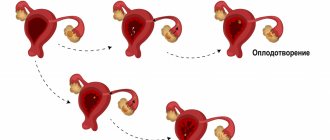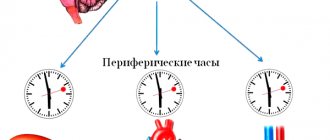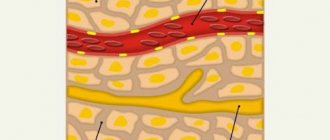There is probably no person in the world who has never experienced external bleeding in their life - for example, from careless handling of a knife when cutting food or from an unfortunate fall from a bicycle that ends in broken knees. The rules of first aid in such situations are simple and well known to everyone. You need to disinfect the wound and stop the bleeding with a bandage or plaster. And if a large vessel (artery) is hit and blood spurts out, then it is necessary to clamp the vessel above the wound site to avoid large blood loss.
Obviously, any bleeding occurs due to the fact that the integrity of the blood vessels is disrupted. Blood stops circulating in the closed space of the vessels and flows out of them. If the integrity of the uterine vessels is compromised, blood flows out through the vagina. It is this external sign that is the reason to suspect something is “off” and consult a doctor.
Uterine bleeding is a symptom of many diseases. These may be gynecological or oncological diseases, as well as complications of pregnancy and childbirth.
In case of uterine bleeding, it is very important not so much to stop the blood loss - this, by the way, is not always the first priority measure - but to identify the cause of the bleeding and, if possible, eliminate it. If this is not done, then there is a high probability of relapse and other manifestations of the disease, as well as its complications. Manipulations aimed at stopping bleeding are carried out in cases where the process of blood loss occurs at a high rate - in this case there is a direct threat to life. After the bleeding has been eliminated, in addition to treatment, restorative procedures must be prescribed: regimen, nutrition, maintaining water balance in the body, vitamin therapy.
Dysfunctional uterine bleeding
Dysfunctional uterine bleeding is bleeding associated with dysfunction of organs, in the absence of any organic pathology (uterine fibroids, internal endometriosis, pathology of the cervix, tumors of the uterus and ovaries).
Ovarian dysfunction is caused by a violation of their hormonal function and occurs quite often. Many women take this disease lightly and do not see it as a direct threat to health. In addition, there is a very common opinion that dysfunction is just a minor malfunction of the body, with which you can live safely, but it is useless to treat it. This approach is fundamentally wrong. Firstly, ovarian dysfunction may be a manifestation of some deep hormonal imbalances that require certain correction. Not to mention that it is unlikely that you will be able to “live well,” because dysfunction is almost always accompanied by physical and moral discomfort and pain. A woman is forced to constantly use analgesics, the body gradually gets used to them, the pain intensifies again... It turns out to be a vicious circle.
The main symptom of dysfunctional bleeding is irregular menstrual cycle. The reason to consult a doctor is when the interval between menstruation is less than 21 days and more than 35 days. It is also not considered normal if:
- menstruation lasts more than 7 days;
- menstrual bleeding is very heavy, a woman is forced to change pads or tampons every hour, including at night;
- Menstruation is accompanied by severe nagging pain in the lower abdomen.
If such symptoms recur over three or more menstrual cycles, then you need to visit a doctor as soon as possible.
Endocrine causes are not always the cause of dysfunction. The functioning of the ovaries can also be affected by factors such as:
- overweight or underweight;
- diabetes;
- frequent stress and depression;
- infectious diseases (flu, pneumonia, sore throat);
- strict diet and fasting;
- genital infection;
- sudden climate change.
Therefore, when going to see a doctor, be prepared that he will ask you questions about your diet, nervous stress, previous diseases and changes in the climatic environment.
Diagnosis of ovarian dysfunction includes a gynecological examination, smear analysis, blood test for hormones, ultrasound of the thyroid gland, adrenal glands and pelvic organs. The doctor may also prescribe magnetic resonance imaging of the brain and separate diagnostic curettage of the uterus.
Treatment is selected individually in each case. First of all, it is aimed at normalizing hormonal levels and correcting lifestyle. In any case, the doctor tries to choose the most gentle therapy. In cases where adolescents or premenopausal women suffer from dysfunction, it is often enough to reduce the level of tension, review the diet and allocate time for active rest and good sleep. The body reacts sensitively to changes that are favorable to it and successfully self-regulates without drug treatment.
Causes
The main factors for the occurrence of bleeding are the following:
- termination of pregnancy, whether voluntary (abortion) or involuntary (miscarriage);
- if the birth of the child was accompanied by a caesarean section;
- frequent diets that lead to poor health;
- difficulties with the general hormonal picture, acute imbalance;
- lack of iron and vitamins;
- blood diseases;
- changes in blood coagulation;
- prolonged depression, stress;
- infectious lesions;
- heavy physical activity and lifting and carrying heavy objects;
- inflammation of the reproductive system;
- gynecological abnormalities;
- cancerous tumors.
Bleeding due to uterine fibroids, adenomyosis, endometrial and cervical canal polyps
Uterine fibroids, endometriosis and polyps and endometrial hyperplasia are diseases associated with benign growth of uterine tissue. They appear most often during reproductive age.
All this pathology is easily diagnosed using ultrasound. As a rule, no additional examination methods are required. You can read about possible treatment options for uterine fibroids in the corresponding section of the website www. ya-zdorova.ru. In the presence of pathology of the uterine cavity, hysteroscopy with the appropriate amount of surgical intervention is indicated to eliminate the cause of bleeding.
Description of normal menstrual flow
If a woman develops normal, physiological menstruation, the following properties are determined:
- During the day, on average, 40-60 ml of menstrual blood is released;
- on the first day the blood has a scarlet, bright tint;
- on the second and subsequent days, the discharge becomes darker, appears not abundantly, but in portions;
- in the last 2 days, discharge begins only with heavy load, sudden movements, or moving the body from a horizontal to a vertical position;
- presence of an odor similar to meat.
On the second and subsequent days, the shade of the discharge is different for each woman. The presence of a small amount of mucus secreted in the vagina is considered normal.
Consultation with a gynecologist is recommended for any changes. It is especially necessary to monitor changes in the shade of the discharge, its volume, and quality.
Bleeding in cancer
One of the first manifestations of uterine and cervical cancer is uterine bleeding, although, as a rule, the process may not be at such early stages. It may not cause the woman any painful sensations, be scanty and short-lived. If such bleeding occurs during a regular menstrual cycle, you should immediately consult a doctor.
A timely visit to a gynecologist allows you to detect a tumor at an early stage and significantly increases the chances of a successful cure. The diagnosis can be made based on a gynecological examination, ultrasound and a number of tests.
Doctors' opinion
Doctors advise women to learn how to distinguish periods from implantation bleeding at home without undergoing tests. So, uterine bleeding with the onset of pregnancy carries a threat of miscarriage and you need to urgently contact a gynecologist. It is important to identify in time the bleeding that has begun, to monitor how and in what portions it leaves, or whether it began during menstruation. It is also important to be able to correctly provide first aid before the ambulance arrives in the event of heavy, profuse blood loss. So, you need to do the following:
- place the patient in a comfortable position;
- slightly raise the pelvic area by placing a pillow;
- apply a cold compress to the lower abdomen to narrow the vessels of the uterus;
- open the window and ventilate the room.
Treatment of bleeding directly depends on the provoking factors that lead to decreased blood clotting and signs of anemia. It is important for women to take care of their health:
- do not lift heavy objects;
- dose physical activity;
- review your diet and include foods high in iron;
- relax more, walk in the fresh air;
- refuse to visit the steam room, sauna, hot bath;
- do not drink alcoholic drinks or strong coffee;
- apply ice to the lower abdomen when there is blood discharge, but for 15 minutes, no more, in order to avoid colds;
- respond in time to the appearance of pathological discharge, especially when accompanied by pain, pain, ichor, pus, and an unpleasant odor.
Obstetric hemorrhage
This term refers to intense bleeding that occurs immediately after childbirth. Their cause is a violation of the contractility of the uterus (atony or hypotension of the uterus), or a pathology associated with the blood coagulation system. Hypotony is a decrease in the tone of the uterus, which leads to its inability to actively contract. Atony is a complete loss of the ability to contract and respond adequately to medications and other types of stimulation. Obstetric hemorrhage is very dangerous because it leads to a large loss of blood in a short time. Very often the question is literally about saving a woman’s life - and then doctors decide on a hysterectomy, that is, removal of the uterus.
Bleeding during menopause
Menopause is a natural physiological process. You shouldn’t be overly emotional or wary about him. But at the same time, a woman during menopause needs to listen to her condition so as not to miss truly significant and alarming symptoms. One of them is bleeding.
Uterine bleeding during menopause may indicate disturbances in the functioning of the hormonal system, the occurrence of tumors in the body of the uterus or in the ovaries. Only a doctor can correctly diagnose the disease using ultrasound and tests.
I would like to say a few words about bleeding during sexual intercourse. If this symptom appears, you should definitely consult a doctor. They may indicate cervical disease, be a manifestation of endometriosis, as well as vaginal pathology. In some cases, spotting during sexual intercourse may be associated with dryness of the vaginal mucosa, for example, during the postmenopausal period. In any case, to clarify the diagnosis, you must consult a doctor.
Opinion of gynecologists
The appearance of spotting outside of menstruation should not be ignored. A woman should definitely see a specialist in order to understand with him the cause of metrorrhagia. Depending on the type of disease, doctors prescribe therapy. But their main task is to stop bleeding.
Gynecologists warn that blood during menopause often means the appearance of tumors, so diagnosis is mandatory. But in any case, only a doctor can determine the cause of bleeding, and it is better to avoid self-medication. Incorrect diagnosis will lead to serious consequences.
How to feel about “grandmothers’ recipes”?
In preparing this article, we conducted a survey and found out that, without exaggeration, a huge number of women are trying to cope with the situation of uterine bleeding on their own - using traditional medicine recipes. Naturally, in this case we are talking about moderate or scanty bleeding. The reasons for this state of affairs most likely lie in the absence of a certain culture of treatment and constant monitoring of one’s health. On the other hand, many books and brochures with various folk recipes can now be bought at any bookstore. It is also not difficult to find such information on the Internet. Recipes based on nettle, yarrow, St. John's wort, and viburnum are presented there as safe, effective, affordable, and, moreover, tested by several generations of women.
Without criticizing traditional medicine and recognizing its merits, we would like to focus your attention, first of all, on the inadmissibility of self-medication in case of uterine bleeding. As noted above, the causes of bleeding can be different. Bleeding is only a consequence, a symptom of the disease. You need to treat what caused it: tumor, dysfunction, uterine fibroids, endometriosis, etc. Therefore, it is extremely important to consult a doctor in a timely manner and correctly diagnose the causes of bleeding. And only then, in the treatment regimen, in some cases folk remedies can be used.









